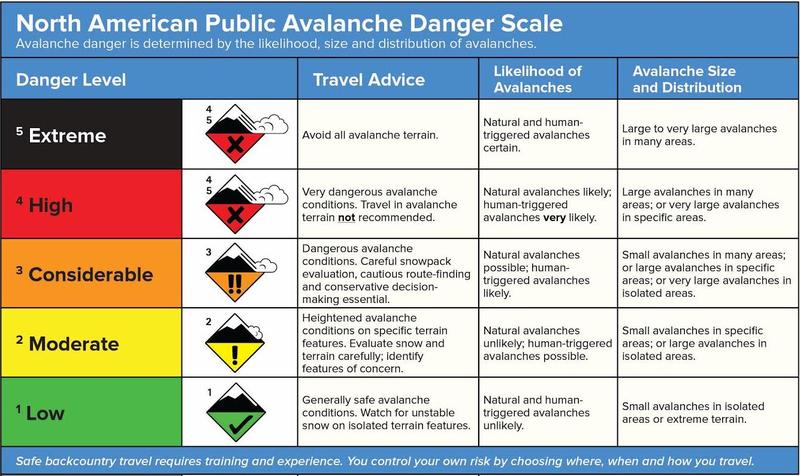
Paige Pagnucco
Director, Forest Service Utah Avalanche Center

For avalanche forecasters, choosing the appropriate avalanche danger level is a difficult process. It may appear obvious to move down the scale once immediate storm instabilities have stabilized, but it is a bit more complicated when the avalanche problem is a buried persistent weak layer. According to James Floyer at Avalanche Canada, having a persistent weak layer buried in the snowpack "decouples the avalanche hazard from the storm cycle." Though over time it may become harder to trigger an avalanche that fails in a buried persistent weak layer, they are no less dangerous as they can be triggered remotely or perhaps from lower-angled terrain well down the slope.
When choosing a danger rating, forecasters take into account the likelihood, size, distribution, as well as the type of avalanches that are possible. Based on the selected rating, the North American Danger Scale offers travel advice. One thing to note is that the danger scale is NOT LINEAR, it is EXPONENTIAL. Think of it this way, if LOW = 2, then MODERATE = 4, CONSIDERABLE = 8, HIGH = 16, and EXTREME = 32. There is a doubling of the danger when increasing to the next level. Maybe this might help someone better understand the nature of the rating system. The line between each level is not black and white either. Imagine if you will a color spectrum where yellow (MOD) flows into orange (CONS), like a rainbow. We have to choose one level for the bottom line but the written forecast itself helps identify where on that spectrum the danger actually lies. For example, the high end of MOD (imagine orangey yellow) is closer to the low end of CONS (yellowy orange) than it is to solid LOW (green). That is why we strongly encourage people to read the forecast - the devil is in the details.
Most UAC forecasts have had an overall CONSIDERABLE danger rating throughout much of December. It is especially challenging to move between MODERATE and CONSIDERABLE as the difference between the two ratings when dealing with a buried persistent weak layer (PWL) is tenuous. The main thing that changes is the likelihood - not the size or distribution - of the avalanches. Slabs failing on a PWL fall into the informally named "unmanageable" category of avalanches. "Unmanageable" avalanches are slab avalanches that may be triggered remotely, or when you're half-way down the slope, or if you're the 7th person on the slope, or the 25th. PWL avalanches are predictable only in their unpredictability. (Hardesty- https://utahavalanchecenter.org/blog/15914)
PWL's make forecasters lose sleep mainly because it is hard to tell when the instability has "healed." As the danger of triggering a PWL avalanche becomes more isolated, it is like gambling every time someone tests a suspect slope. The weak facets on one slope may not fail while on another similar slope they may give way when a rider is mid-slope. Signs like cracking and collapsing become less apparent and prevalent over time.
Between December 18th and 26th, 2020, there were four avalanche fatalities in Colorado. All of these avalanches failed on a buried PWL. We take these layers very seriously as forecasters. Our job is to give backcountry travelers the information they need to avoid finding out the hard way about PWL's. The message will continue to be one of caution and respect until the weakness disappears.
Here are a couple of resources about the avalanche danger scale:
Danger in the Danger Ratings - https://utahavalanchecenter.org/blog/15914
Avalanche Danger Scale - https://utahavalanchecenter.org/avalanche-danger-scale
A Zoom discussion of this topic between UAC forecasters Paige Pagnucco and Greg Gagne:
Great discussion! I really appreciate all your efforts to help the public understand the limitations of the danger scale when it comes to persistent weak layers. Happy new year.
Heather Thamm (not verified)
Fri, 1/1/2021
Thanks for this discussion. It was clear and informative.
Lisa Ward (not verified)
Tue, 1/5/2021






